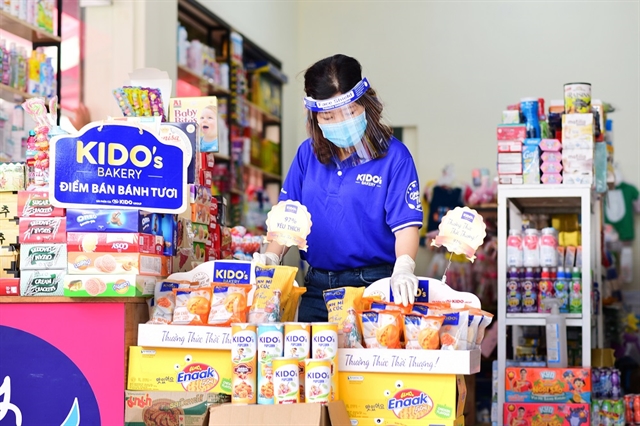 Economy
Economy


|
| A KIDO's bakery in Hà Nội. KIDO this year targets its highest pre-tax profit since 2017, around VNĐ900 billion. Photo baotintuc.vn |
HÀ NỘI — The race in the confectionery market is looking more attractive for KIDO Group (KDC) since returning to the market two years ago to compete against other big brands such as Pan Group’s Bibica, Mondelez Kinh Đô and Hữu Nghị Food.
KIDO Group transferred its confectionery business to a foreign partner with a commitment to not participate in the sector for five years. After a six-year absence, it officially returned to the confectionery industry in October 2021. After heavy investment in the KIDO Bakery brand, the company now aims to be the No. 2 position in the bakery industry in Việt Nam within the next three to five years.
KIDO this year is targeting its highest pre-tax profit since 2017. Accordingly, the company has set a net revenue goal of VNĐ15 trillion and a pre-tax profit of VNĐ900 billion for 2023, up 20 per cent and 76 per cent respectively compared to the previous year.
KIDO also carried out a strategy to restructure the business this year into four sub-groups focussing on cooking oil, ice cream, confectionery and fish sauce.
According to Trần Lệ Nguyên, general director of KIDO, the step is to create conditions for the company to link with multinational companies in each segment. KIDO's products will not be only consumed domestically but also exported, which will help improve the company’s profit margins. If the price of raw materials is stable, the profit will increase even more.
KIDO’s board of directors has also submitted a plan to shareholders for approval to reduce the rate of special dividend in 2022 to 10 per cent in cash, instead of 50 per cent as previously approved. KIDO said the dividend reduction is based on the reality on the ground as well as new investment plans this year. KIDO has recently completed the acquisition of a 25 per cent stake in the Thọ Phát Dumplings brand and plans to increase its ownership of Hùng Vương Plaza to 76 per cent.
According to the latest data from market research company Euromonitor, KIDO is currently the market leader in the ice cream industry with a share of 44.5 per cent, of which the Merino brand accounts for 24.2 per cent and the Celano brand accounts for 19.2 per cent.
KIDO is also leading the margarine industry in Việt Nam with a market share of 74.9 per cent and ranks second in cooking oil with about 30 per cent of the market share.
PAN Group is another top confectionary brand in the country. At its annual general meeting of shareholders, Nguyễn Duy Hưng, chairman of PAN Group’s board of directors, said the business plans of each member company and PAN Group itself have been developed under careful guidance.
Specifically, PAN Group’s consolidated revenue and profit in 2023 will increase by 8 to 9 per cent compared to 2022 to more than VNĐ15.15 trillion and VNĐ991 billion.
PAN Group’s leaders have identified food and confectionery as its core business segments with a revenue growth of 15 per cent thanks to the gradual recovery of domestic demand. Pre-tax profits from the company’s core business activities are expected to double over 2022 (excluding extraordinary profits from plant transfer transactions).
PAN Group is considered a big player in the country’s agriculture, fishery, and confectionery industries with many big brands under its control. In particular, in the confectionery segment, it completed the acquisition of the famous Bibica in the middle of last year with ownership increasing to 98.3 per cent.
Besides KIDO and PAN Group, the country’s confectionery market also has the participation of other big names such as Mondelez Kinh Đô (UK), Orion (Korea), and domestic brands such as Hữu Nghị and Hải Hà.
The race of big names in the confectionery industry is not only happening in the domestic market that has an average growth rate of only 5 to 8 per cent a year. For faster growth, many companies choose to find new markets through export.
Nguyễn Quốc Hoàng, general director of Bibica, told the company’s investor conference last year that this was not the time for Bibica to be on the defensive.
The statement of the head of Bibica, as well as the market developments and the targets of remaining domestic confectionery companies, show giants in the local confectionery industry are considering long-term and sustainable plans to export. — VNS




